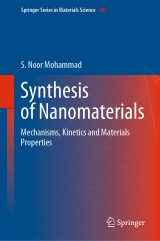Details

Synthesis of Nanomaterials
Mechanisms, Kinetics and Materials PropertiesSpringer Series in Materials Science, Band 307
|
CHF 165.50 |
|
| Verlag: | Springer |
| Format: | |
| Veröffentl.: | 27.10.2020 |
| ISBN/EAN: | 9783030575854 |
| Sprache: | englisch |
Dieses eBook enthält ein Wasserzeichen.
Beschreibungen
This book deals with the synthesis of nanomaterials with a strong focus on the underlying reaction kinetics and various synthesis mechanisms. It gives a detailed description of all major synthesis routes of many types of novel nanomaterials including nanowires, carbon nanotubes, semiconductor nanotubes, carbon nanobelts, nanofibers, nanorings, nanodots and quantum dots. In addition, it articulates the fundamental mechanisms of nanomaterials synthesis via vapor-phase, liquid-phase and solid-phase processes, highlighting the various strengths and weaknesses of each mechanism. This monograph provides the reader with a thorough review of the known state-of-the-art, along with a detailed comparison and analysis of all possible nanomaterials synthesis mechanisms. An important element of the book is how to obtain critical knowledge for controlling the morphology of nanomaterials and thereby fine tune their materials properties. The book is an ideal guide for graduate students and researchersnew to the field seeking to establish or enhance their understanding of the physical and chemical fundamentals of nanomaterials synthesis mechanisms.
<p>Introduction.- Nanomaterials Synthesis Routes.- Catalyst Nanoparticles.- Synthesis and Pre-Synthesis Occurrences.- Vapor-Solid-Liquid (VLS) Growth Mechanism.- Vapor-Solid-Solid (VSS) Growth Mechanism .- Vapor-Solid (VS) Growth Mechanism.- Solution and Supercritical Fluid Based Growth Mechanisms.- Solid-Liquid-Solid (SLS) Growth Mechanism.- Oxide-Assisted Growth (OAG) Mechanism.- Self-Catalytic Growth (SCG) Mechanism.- Vapor-Quasiliquid (Quasisolid)-Solid (VQS) Growth Mechanism.- Catalyst-Mediated VQS Growth Mechanism.- Catalyst-Free VQS Growth Mechanism.- Simple Theoretical Model for VQS Growth Mechanism.- The Universal, Versatile Growth Mechanism.- Conclusions.</p>
S. Noor Mohammad was born in the village of Paruldihi, West Bengal, India, and graduated from Golgram High School with the highest distinction. He was one of the top 20 graduating students among 1,760,000 students who were examinees at the School Final Examination in the entire West Bengal State Board of Secondary Education, West Bengal, India. He obtained his B.Sc. with Honors in Physics from Midnapore College (University of Calcutta), his M.Sc. in Physics from North Bengal University, Darjeeling, West Bengal, India, his PhD in Physics (Chemical and Solid-State Physics) from the Indian Institute of Technology, Kharagpur, West Bengal, India, and his D.Sc. degree in Physics from the University of Calcutta. Following his D.Sc., he came to the USA in September of 1979, where he carried out extensive postdoctoral research in materials science and engineering at Case Western Reserve University and the University of Illinois at Urbana-Champaign. He had been with the IBM Semiconductor Research and Development Center in New York before moving to Howard University in Washington, DC. He became Professor of Electrical Engineering at Howard University, where he founded externally funded large Nanomaterials Science and Engineering Research Program. He is currently retired and affiliated with a small, self-established non-profit organization, Sciencotech.
This book deals with the synthesis of nanomaterials with a strong focus on the underlying reaction kinetics and various synthesis mechanisms. It gives a detailed description of all major synthesis routes of many types of novel nanomaterials including nanowires, carbon nanotubes, semiconductor nanotubes, carbon nanobelts, nanofibers, nanorings, nanodots and quantum dots. In addition, it articulates the fundamental mechanisms of nanomaterials synthesis via vapor-phase, liquid-phase and solid-phase processes, highlighting the various strengths and weaknesses of each mechanism. This monograph provides the reader with a thorough review of the known state-of-the-art, along with a detailed comparison and analysis of all possible nanomaterials synthesis mechanisms. An important element of the book is how to obtain critical knowledge for controlling the morphology of nanomaterials and thereby fine tune their materials properties. The book is an ideal guide for graduate students and researchersnew to the field seeking to establish or enhance their understanding of the physical and chemical fundamentals of nanomaterials synthesis mechanisms.
Gives a detailed description of all major synthesis mechanism of many different types of nanomaterials Familiarizes the reader with the state-of-the-art as well as the pros and cons of each mechanism Provides knowledge critical for controlling the morphology and properties of nanomaterials
Diese Produkte könnten Sie auch interessieren:

Introduction to Focused Ion Beams

von: Lucille A. Giannuzzi, Lucille A. North Carolina State University

CHF 153.50















